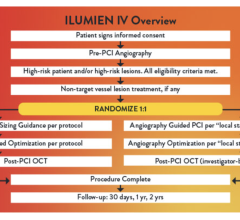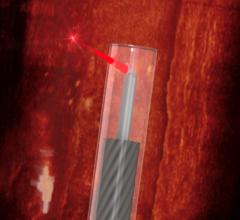
August 11, 2010 – Development of an optical coherence tomography (OCT) imaging system built into an angioplasty balloon is described in the journal Review of Scientific Instruments, which is published by the American Institute of Physics, holds the potential to greatly improve angioplasty.
An optimal balloon design is critical to the success of an operation. Balloons can now be tested in a balloon deployment tester equipped with a system to monitor the outer diameter of the balloon, according to Guy Lamouche, research officer at the National Research Council of Canada. With the goal of improving balloon deployment, the researchers investigated obtaining a more precise monitoring of balloon inflation by combining a deployment tester with an OCT imaging system.
OCT allows imaging over a depth of a few millimeters in a tissue or material. By performing a pullback (rotation and translation) of a catheter OCT probe in a balloon, they discovered that it's possible to obtain a precise measurement of the balloon's diameter and thickness over the entire balloon.
"Combining OCT with a balloon deployment system provides an improved platform for angioplasty balloon development and can also be used in the development of next-generation minimally invasive devices for percutaneous -- through the skin -- coronary interventions," said Lamouche. "It's now possible to monitor balloon inflation within an artery phantom (model) or an excised artery to assess the efficiency of innovative balloon angioplasty or stent deployment procedures."
The article, "Optical coherence tomography monitoring of angioplasty balloon inflation in a deployment tester" by Hamed Azarnoush, Sebastien Vergnole, Rafik Bourezak, Benoit Boulet, and Guy Lamouche will appear in the journal Review of Scientific Instruments.
The journal is devoted to scientific instruments, apparatus, and techniques. Its contents include original and review articles on instruments in physics, chemistry, and the life sciences; and sections on new instruments and new materials. One volume is published annually.
For more information: http://rsi.aip.org/rsinak/v81/i8/p083101_s1


 August 29, 2023
August 29, 2023 








